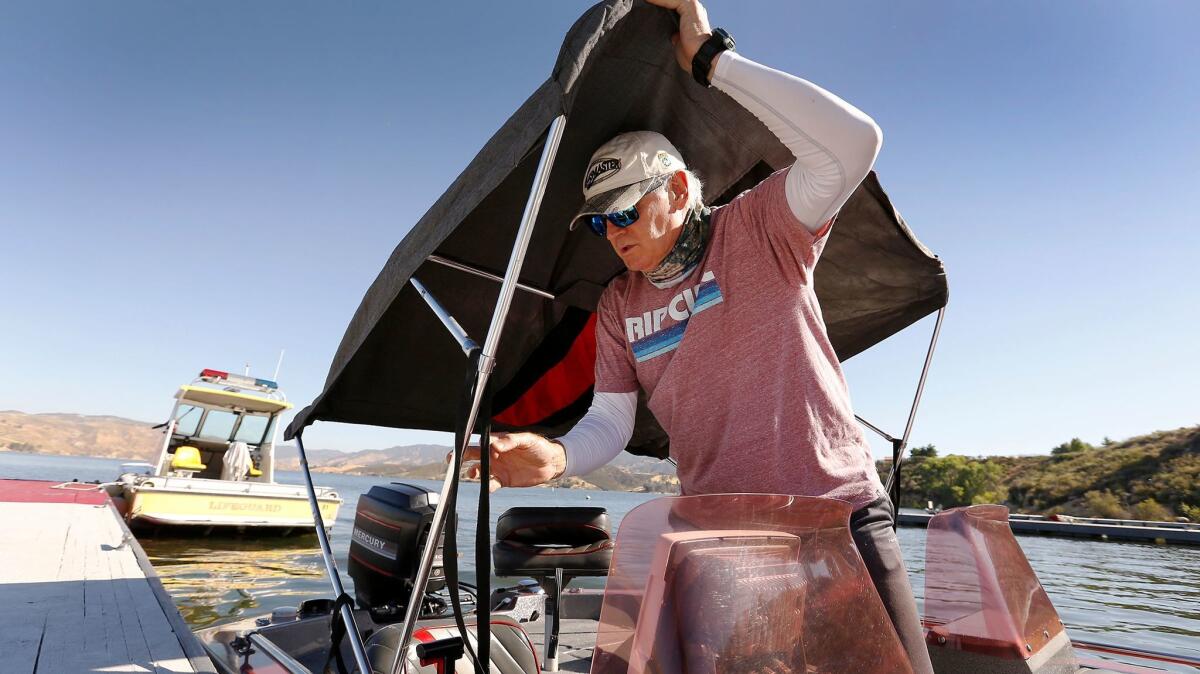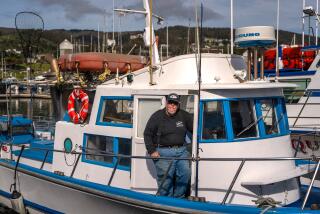California’s lakes are full again but fishing remains in a drought

As he prepared to launch his fishing boat from the dock at Castaic Lake, longtime angler Dan Curtis recalled conditions two years earlier when the state’s worst drought shriveled the reservoir to nearly a third of its total capacity.
“It was like fishing on the surface of the moon,” he said, describing how Castaic’s bare, rocky shores stretched nearly a quarter of a mile from the launch ramp.
The lake is now near capacity, but below the surface of the water, not everything has returned to normal.
Five years of drought have stunted the size of the bass that spawned in the 3 1/2-square-mile reservoir near Santa Clarita, and Curtis has mostly been catching 6-inch-long bass — about half the size before the drought.
An above-average snowfall this winter was good news for the state’s $2.7-billion sport-fishing industry. But conditions have yet to recover at many lakes and reservoirs in Southern California, and deep snow, ice and snow melt have put some high-elevation lakes and creeks in the Sierra Nevada out of commission.
A full recovery from the drought could take another two or three years, said Curtis, a retired computer systems analyst who has been fishing Castaic for more than 30 years.
“If we get another good rain season this year, we could be good for years,” he said, before motoring into the depths of the lake with an array of rods spread across the deck of his boat.
With its year-round sunshine and diverse topography, California is home to more than 1.3 million freshwater anglers, behind only Texas, Minnesota and Michigan, according to the American Sportfishing Assn.
Those numbers make it a big business. California’s freshwater anglers spend more than $1.4 billion a year on gear, fees, gasoline and other expenses, supporting 21,500 jobs and generating more than $400 million on state and federal taxes, according to the trade group.
Anglers and fishing gear vendors rejoiced when the 2016-17 winter dropped one of the largest snowpacks in California’s recorded history, filling up lakes and reservoirs to pre-drought levels while turning dry rivers into fast-moving rapids.
So far this year, sales of fishing licenses are on track to match the 1.07 million recreational licenses sold last year, according to the state’s Department of Fish and Wildlife.

But the wet winter has yet to deliver a dream fishing season.
Knee-deep rivers that are prime hunting grounds for fish have become waist-deep torrents, moving too fast to fish.
“Fishing is pretty slow in all areas,” said Tom Loe, owner of Sierra Drifters Guide Service, located near Mammoth Lakes in Mono County. The Owens River, which runs through the Owens Valley east of the Sierra Nevada mountains, is swollen with snowmelt in many sections, making the water too deep and the current too rapid to fish.
“The Owens River is running too fast, 10 times what it was running before this winter,” Loe said.
Although fishing season typically begins in late April, many of the popular high-elevation lakes in the Eastern Sierra — such as Saddlebag Lake west of Lee Vining and the Twin Lakes near the town of Mammoth Lakes — are still frozen or have only recently thawed. That has shifted demand to the lower-elevation fishing lakes, such as Crowley and Convict lakes, Loe said.
“We are seeing a huge influx of people visiting this area,” he said.
And even for those high-elevation lakes that have thawed, anglers say that the snowmelt continues to make access difficult.
Jim Reid, owner of Ken’s Sporting Goods in Bridgeport, said Barney Lake, in the Sierra Nevada southwest of Bridgeport, has begun to thaw but “there is so much water coming off the mountain that the valley is a big sloppy mess.”
Making matters worse, some lower-elevation lakes that receive water from the state’s water project have been choked with fast-moving snowmelt that carries silt, soil and minerals downstream, anglers complain.
“The water is dirty brown, like chocolate milk,” groused Edward Cazares, tournament director for the California Bass Contenders, a fishing club based in San Dimas.
He said such conditions at Lake Perris, Pyramid Lake and Silverwood Lake have made it hard on anglers.
“As the rainfall came, everyone thought and hoped for a great season. It just didn’t happen that way,” he said.
Still, not all the news for fishermen is bad. Some anglers are reporting good conditions as long as fish hunters are willing to work a little harder to hook their prey.
Mark Franco, a fishing guide in Riverside and San Bernardino counties, said Diamond Valley Lake, a man-made reservoir in Hemet, is nearly full. But brush and vegetation that grew along the shore during the drought is now underwater and creating hiding spots for the fish.
“If you fish in the sticks and bushes, you can pull out some nice fish, but you are going to lose some tackle,” Franco said. “You are just going to have to learn the lake again.”
Back at Castaic Lake, retired firefighter Wick Wright recalled how much easier it was to fish in the smaller, drought-stricken version of the massive reservoir.
“Toward the end of the drought there was no place for the fish to hide,” he said as he prepared to launch his fishing boat, targeting striped bass in the deepest parts of the lake.
“Still, I’m happy to see more water,” he said. “This is the way it should be.”
To read more about the travel and tourism industries, follow @hugomartin on Twitter.







